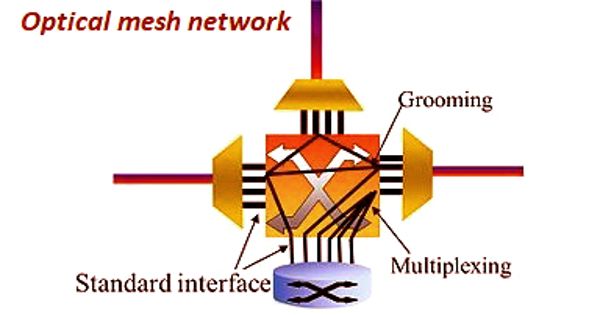An Optical Network is basically a communication network used for the exchange of information through an optical fiber cable between one end to another. An optical mesh network is a type of optical telecommunications network employing wired fiber-optic communication or wireless free-space optical communication in mesh network architecture. It is a telecommunication network that uses optical fiber, synchronous digital hierarchy, and ring architecture. The major advantage of using an optical mesh network is trunking. This is the ability to have multiple routers and switches interconnected with each other. Optical mesh networks also support backup and recovery plans for established networks in case of any disaster, damage, or failure.
Optical mesh networks were a huge advancement in optical fiber telecommunication network systems. Most optical mesh networks use fiber-optic communication and are operated by internet service providers in metropolitan and regional but also national and international scenarios. OMN networks evolved from the digital-cross-connect systems with mesh architecture that were used in the 1980s. It refer to transport networks that are built directly off the mesh-like fiber infrastructure deployed in metropolitan, regional, national, or international areas by deploying optical transport equipment that are capable of switching traffic from an incoming fiber to an outgoing fiber.

The new mesh optical technology is similar to the old ring networks but much cheaper and much more efficient. They are faster and less error-prone than other network architectures and support backup and recovery plans for established networks in case of any disaster, damage, or failure. These are frequently used for big networking systems, such as those in large cities. Optical mesh networks today not only provide trunking capacity to higher-layer networks, such as inter-router or inter-switch connectivity in an IP, MPLS, or Ethernet-centric packet infrastructure but also support efficient routing and fast failure recovery of high-bandwidth point-to-point Ethernet and SONET/SDH services.
Applications
The deployment of optical mesh networks is enabling new services and applications for service providers to offer their customers, such as –
- Quality of Service (QoS) protection, allowing services with different levels of protection;
- Dynamic services such as Bandwidth-on-Demand (BoD), Just-In-Time (JIT) bandwidth, bandwidth scheduling, and bandwidth brokering;
- Optical virtual private networks;
- Multicast lightpaths.
Currently planned satellite constellations aim to establish optical mesh networks in space by using wireless laser communication. Optical transport networks have introduced new standards in telecommunication systems by providing high speed data communication, higher bandwidth and extraordinary trunking capacity for higher and heavy networks layers. OMNs allow these devices to speed up routing in combination with error detection/fault removal solutions to create a faster and less error prone network.
Information Source:
















